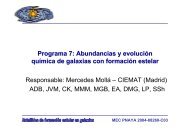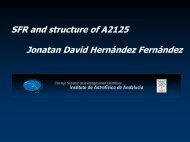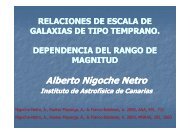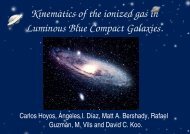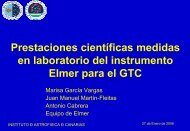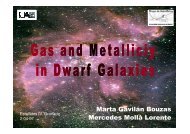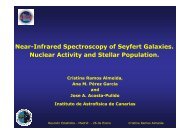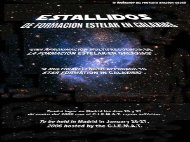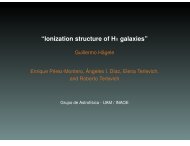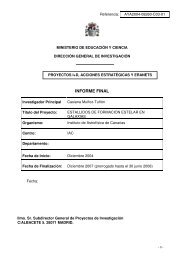Spatial distribution of Lyman alpha emission
Spatial distribution of Lyman alpha emission
Spatial distribution of Lyman alpha emission
- No tags were found...
You also want an ePaper? Increase the reach of your titles
YUMPU automatically turns print PDFs into web optimized ePapers that Google loves.
<strong>Spatial</strong> <strong>distribution</strong> <strong>of</strong><br />
<strong>Lyman</strong> <strong>alpha</strong> <strong>emission</strong><br />
J. Miguel Mas-Hesse<br />
Daniel Kunth<br />
Matthew Hayes<br />
Claus Leitherer<br />
Artashes Petrosian<br />
et al............
<strong>Lyman</strong> <strong>alpha</strong> <strong>emission</strong> in starbursts<br />
• <strong>Lyman</strong> <strong>alpha</strong> should be the strongest <strong>emission</strong> lines in<br />
HII regions.<br />
• But it is strongly affected by multiple scattering in the<br />
neutral HI gas.<br />
• We know that the <strong>Lyman</strong> <strong>alpha</strong> <strong>emission</strong> line in<br />
starbursts shows <strong>of</strong>ten typical P Cyg pr<strong>of</strong>iles, tracers<br />
<strong>of</strong> outflowing neutral gas.<br />
Estallidos III IAC Dec. 2nd, 2004 J. Miguel Mas-Hesse 2
Haro 2<br />
<strong>Lyman</strong> <strong>alpha</strong> P Cyg pr<strong>of</strong>iles<br />
8”<br />
1kpc<br />
1216 A<br />
Wavelength<br />
Estallidos III IAC Dec. 2nd, 2004 J. Miguel Mas-Hesse 3
• These pr<strong>of</strong>iles are explained as the effect <strong>of</strong> outflowing neutral gas<br />
and allow to derive the kinematical properties <strong>of</strong> the neutral gas<br />
surrounding starbursts.<br />
Estallidos III IAC Dec. 2nd, 2004 J. Miguel Mas-Hesse 4
<strong>Lyman</strong> <strong>alpha</strong> ACS imaging<br />
• We started 2 years ago a programme to obtain <strong>Lyman</strong><br />
<strong>alpha</strong> images with HST-ACS, aiming to map the<br />
properties <strong>of</strong> the neutral gas by comparing the spatial<br />
<strong>distribution</strong> <strong>of</strong> <strong>Lyman</strong> <strong>alpha</strong> and H <strong>alpha</strong> <strong>emission</strong>s.<br />
• We have got only now the first reliable results.<br />
• But it has not been easy at all. Things can be<br />
sometimes much more complicated than expected!<br />
Estallidos III IAC Dec. 2nd, 2004 J. Miguel Mas-Hesse 5
ESO 338-IG04 = Tol1924-416: a test case<br />
Red: OIII<br />
Green: UV continuum<br />
Blue: <strong>Lyman</strong> <strong>alpha</strong><br />
Estallidos III IAC Dec. 2nd, 2004 J. Miguel Mas-Hesse 6
Knot B<br />
Knot C<br />
Knot A<br />
N<br />
E<br />
Estallidos III IAC Dec. 2nd, 2004 J. Miguel Mas-Hesse 7
Knot B<br />
Knot D<br />
Knot C<br />
Knot A<br />
Estallidos III IAC Dec. 2nd, 2004 J. Miguel Mas-Hesse 8
Effects disturbing <strong>Lyman</strong> <strong>alpha</strong> imaging<br />
• Slope <strong>of</strong> the UV continuum (age, reddening)<br />
– Imaging in different colors<br />
• Galactic <strong>Lyman</strong> <strong>alpha</strong> absorption<br />
– Convolution <strong>of</strong> filter with expected Voigt pr<strong>of</strong>ile<br />
• Underlying stellar <strong>Lyman</strong> <strong>alpha</strong> absorption<br />
– Calibration with stellar atmosphere models<br />
• Regions with P Cyg pr<strong>of</strong>ile yield net zero <strong>Lyman</strong> <strong>alpha</strong><br />
<strong>emission</strong><br />
– Comparison with H <strong>alpha</strong> allows to identify these regions, and<br />
to map where the HI gas is outflowing.<br />
• All they have to be converted into a Continuum<br />
Throughput Normalization factor (CTN) for the ACS set<br />
<strong>of</strong> filters.<br />
Estallidos III IAC Dec. 2nd, 2004 J. Miguel Mas-Hesse 9
Knot A<br />
(0.7”)<br />
Knot C<br />
Estallidos III IAC Dec. 2nd, 2004 J. Miguel Mas-Hesse 10
Effects <strong>of</strong> age and extinction on UV continuum<br />
Estallidos III IAC Dec. 2nd, 2004 J. Miguel Mas-Hesse 11
Map <strong>of</strong> UV continuum slope<br />
Estallidos III IAC Dec. 2nd, 2004 J. Miguel Mas-Hesse 12
Gal. Lya abs.<br />
Knot A<br />
Geocoronal Lya<br />
Tol1924 HI abs.<br />
Knot C<br />
Estallidos III IAC Dec. 2nd, 2004 J. Miguel Mas-Hesse 13
Estallidos III IAC Dec. 2nd, 2004 J. Miguel Mas-Hesse 14
Estallidos III IAC Dec. 2nd, 2004 J. Miguel Mas-Hesse 15
• Taking all the effects into account, and calibrating the colors with<br />
SB99, we have been able to compute the required CTN factors all<br />
over the image.<br />
Estallidos III IAC Dec. 2nd, 2004 J. Miguel Mas-Hesse 16
Map <strong>of</strong> CTN factors<br />
7 (blue/purple)<br />
to<br />
14 (red/white)<br />
A flat continuum gives<br />
CTN = 10.33 (green)<br />
Estallidos III IAC Dec. 2nd, 2004 J. Miguel Mas-Hesse 17
• Applying these CTN factors, the map <strong>of</strong> <strong>Lyman</strong> <strong>alpha</strong> <strong>emission</strong><br />
Can be produced.<br />
Dark = <strong>emission</strong><br />
Estallidos III IAC Dec. 2nd, 2004 J. Miguel Mas-Hesse 18
Map <strong>of</strong> <strong>Lyman</strong> <strong>alpha</strong> EW<br />
Dark = high EW (-50 to +50 Å)<br />
Estallidos III IAC Dec. 2nd, 2004 J. Miguel Mas-Hesse 19
• We are starting to apply the method to the other galaxies in the sample<br />
Red: Optical continuum Green: UV continuum Blue: <strong>Lyman</strong> <strong>alpha</strong><br />
Estallidos III IAC Dec. 2nd, 2004 J. Miguel Mas-Hesse 20
Conclusions<br />
• Imaging the <strong>Lyman</strong> <strong>alpha</strong> <strong>emission</strong> is a difficult task,<br />
even with narrower filters.<br />
• Photometrical results obtained from high redshift<br />
galaxies should be taken with great care.<br />
• Some additional information (UV slope, age) is in any<br />
case required to interpret correctly this kind <strong>of</strong> data.<br />
Estallidos III IAC Dec. 2nd, 2004 J. Miguel Mas-Hesse 21




